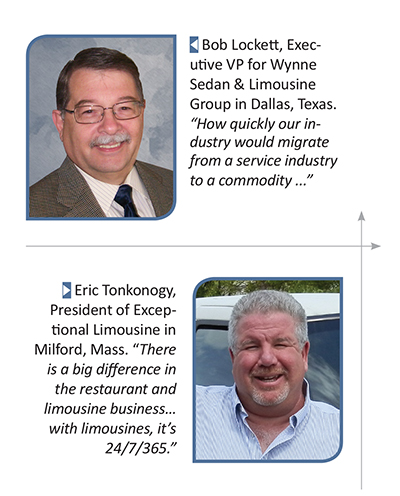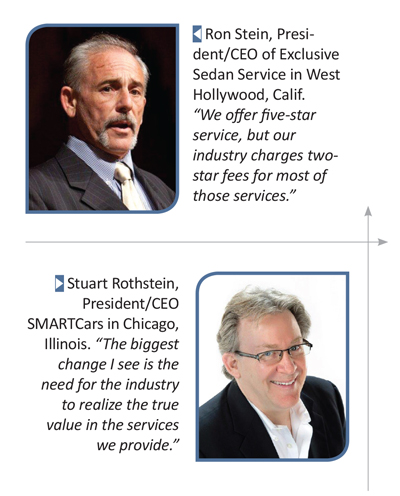BY JOHN GREENE
A chauffeur can sit in his car today and pretty much have at his fingertips everything he needs to know to assist him in getting the job done. The souped-up software on his smartphone tells where his next job is, and a high-tech dashboard GPS that looks like it was lifted from the bridge of the Starship Enterprise tells him how to get there. Even better, it tells him how to avoid all the detours, potholes, and obstructions that might prevent him from successfully completing his mission. 
Twenty-five years ago I wished I possessed the tools to help me find the perfect route to success. When I launched my first company, CTS Limousine, in 1988, I had two cars, no chauffeurs, and a part-time job selling plumbing fixtures. My cell phone was the size of a loaf of bread and not very smart, and the idea of GPS in my car wasn’t even a blip on the technological radar. At that time, the only female voice emanating from my dashboard was Cyndi Lauper telling me that girls just wanna have fun. If a Rand McNally road map couldn’t get me to my next pickup or around construction, I was out of luck. And so was the client.
The Way We Were
What I did have back then was a love of the ground transportation business, which I still have today. What I didn’t have were the resources to understand just what it would take to succeed. There weren’t any significant national limousine trade associations at the time, and maybe only one or two trade shows. I had no idea how to find the right people to work for me, and if I did, how to train them in this Google-less world. But maybe if there were those resources I would have also realized that it was an all-consuming occupation, a 24/7 lifestyle that I wasn’t really prepared for but still came to embrace (enough to launch a second company, ETS International, in 2007 after selling CTS). And if there were more industry resources then to tap in to, maybe there would have also been some inkling that the ground transportation industry operates on a very small profit margin and nobody is getting rich. The one thing we all share is a passion for transporting people safely from start to finish.
When Stuart Rothstein launched SMARTCars in Chicago in 1994, he felt pretty much the same way. “As someone coming from the financial markets (floor trading in Chicago and interbank trading on Wall Street), I knew nothing about the business,” says Rothstein, who now serves as the company’s president/CEO. “I set out to buy taxi medallions, and while performing my due diligence was swayed into investing in one of the only sedan services in Chicago at the time. As it turns out, there were several information gaps that I wish had known then that I know now.” As Rothstein looks back, he sees that:
• Margins are extremely thin and the hours, especially for new and involved owners, can be very long.
• Success is in the hands of individuals who are unseen during the delivery of service and therefore, their successes or failures cannot be known until after the fact, and even then one may not know.
• It is a business that depends on 5 Sigma performances, which by definition makes it challenging to succeed.
• The enormous amount of ancillary knowledge needed by each player (CSR, dispatcher, chauffeur, back office staff) is immense and takes an inordinate amount of time to obtain and master. This makes personnel replacement time consuming and a critical function.
• The “game” is always changing. So to remain successful one must constantly be learning, adapting, and growing.
• Intelligence, patience, insight, personality, commitment, integrity, honesty, and resilience are the pinions in order to have longevity.

Bob Lockett, executive VP for Wynne Sedan & Limousine Group in Dallas, Texas, came on to the scene in the mid-1990s. When he steps into the Wayback Machine, what he remembers is an industry in constant flux. “Several things come to mind, particularly how quickly our industry would migrate from a service industry to a commodity, where quality service was replaced by the lowest-priced provider,” Lockett recalls. “Chauffeured transportation was being replaced by ground transportation.” Lockett also says that even back then there was a need to convince the OEMs to put more money into developing alternative fuel vehicles that could hold up to the day-to-day durability required by the livery business. Sounds familiar, right?
On the West Coast, Ron Stein launched Exclusive Sedan Service in 1980, and is now the president/CEO of the West Hollywood-based company. He says if he had a crystal ball back then, he would have typed in the search box: “A way to know when the business climate would rise and fall, and also which markets to go after for profitability and self fulfillment,” says Stein.
For over 20 years, Eric Tonkonogy’s career path GPS had always been right on course since graduating from Johnson & Wales Culinary College, as he found himself running a chain of restaurants. Then, in 2006 it suddenly chirped, “recalculating,” and he decided to venture off his chosen path and into the ground transportation business, a world he knew absolutely nothing about with very little info readily available. Fortunately, Tonkonogy was able to get some insight into the business from a frequent customer in his restaurant, who happened to be in the limousine industry. He would answer any question about the business Tonkonogy had. “He got me pretty excited about it,” Tonkonogy recalls. “And I figured, hey, it’s probably an easy industry to break into because all I needed was a car.”
Seven years later, Eric Tonkonogy is the president of Exceptional Limousine in Milford, Mass., and the company is doing well in the weddings and special events market. But he’ll be the first to admit that the preconceived idea of an easy path to quick success soon became a long and winding road to a fulltime commitment. While in both businesses you are only as good as your last experience—meal or trip—he soon learned that the limousine industry was far more rigorous. “What I learned right away was there was a big difference in the restaurant and limousine business,” says Tonkonogy. “Although they both have customer service in common, when I locked the door to the restaurant at night, my day was over. With limousines, it’s 24/7/365.”
Oh, the Places We’ll Go
A man far wiser than I once said, “Those who look only to the past or present are certain to miss the future.” So we can all look back at what we might have done differently when we first started out and grouse about the long hours and the small profitability, or we can do two things: be glad we have survived long enough to see the technology that is making our life easier, and figure out how we can be more successful. And as I see it, it all begins with finding a way to stabilize rates across the board that will afford us a reasonable profitability.
This means we have to band together, as an industry, against unrealistic RFPs being sent out that drive our pricing down. As Stuart Rothstein sees it, all this does is lessen our industry in the eyes of our clients. “The biggest change I see is the need for all of the members of this fractured industry to realize the true value in the services we provide,” says Rothstein. “Because if we don’t, we will rise to a level of consciousness in the minds of the travel industry where we are an afterthought and as such remain in a weak position when negotiating price points and communicating the vagaries impacting service delivery.”
Ron Stein agrees, “I, too, would also like to see a higher valuation of chauffeured services,” he says. “We offer five-star service, but our industry charges two-star fees for most of those services.” He also thinks the ground transportation industry would be a better place to operate in with “less unnecessary government controls, mandates, and taxation. “
But for Bob Lockett, the future also has to see more accountability from all ancillary facets of the industry, what he refers to as having some “skin” in the game. “Software providers are not limousine companies, and we can only blame ourselves for subjugating our industry to virtual networks,” he says. “Most of the owners of these companies have never been behind the wheel of a car and have no clue what it takes to operate a limousine company.”
In my crystal ball, the future is still all about banding together to help each other with the stabilization of rates industrywide. There are companies in our industry so desperate to land a job that they are doing it as cheaply as possible, to the point where they are offering internet specials for $50 on a $200 trip. Their business acumen is like a two-ton anchor tied around our necks. And every time they cast it into the water in hopes of landing a job—any job—we are all getting dragged down to the bottom. It’s important for chauffeured ground transportation operators to fully understand what it costs to put a vehicle on the road today, because when the day comes that all of our clients base their buying decisions on the lowest cost instead of top-of-the-line customer service and exceptional value, that is the day I go back to selling bathroom sinks. [CD0613]

